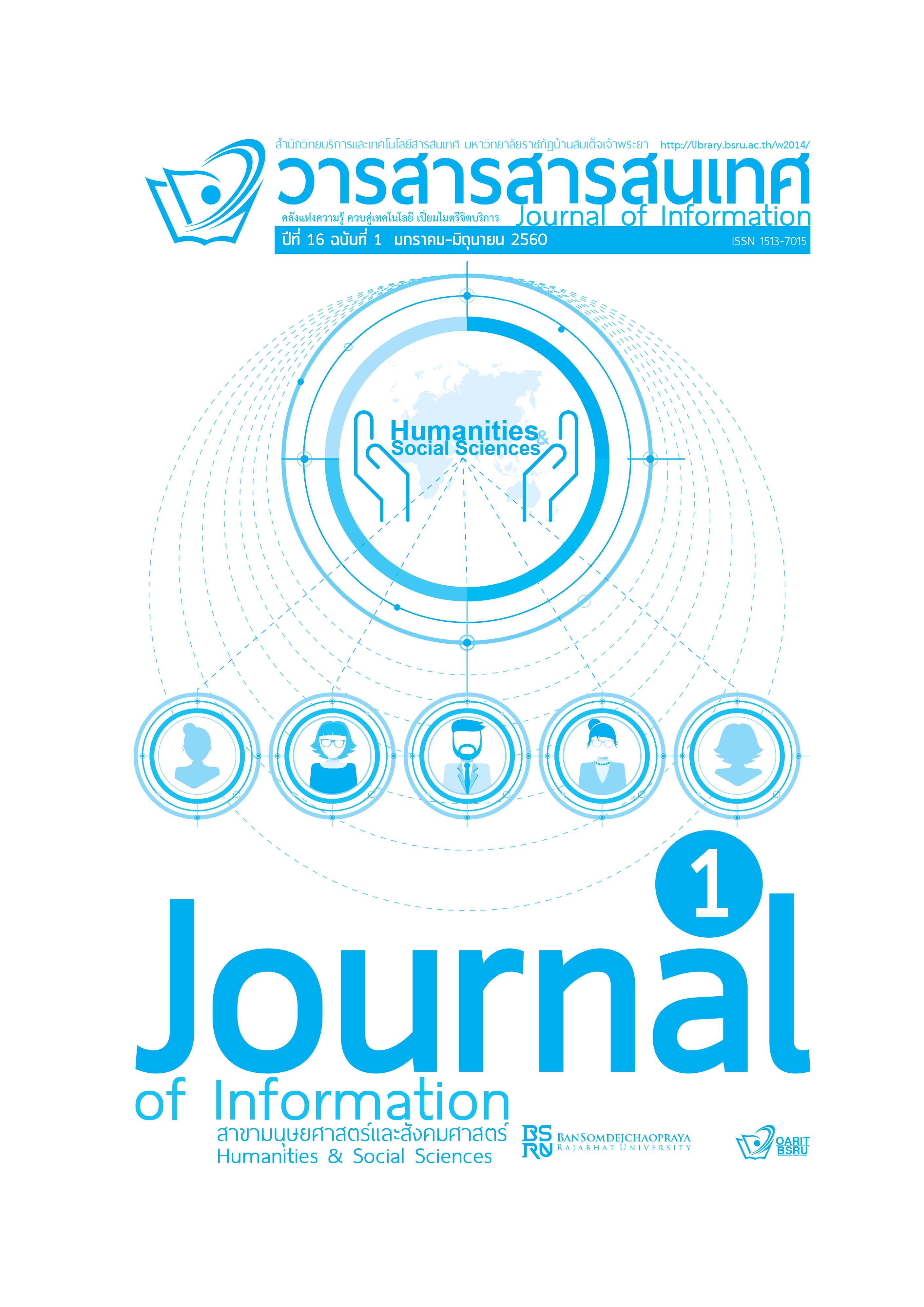ตัวชี้วัดความมีชื่อเสียงขององค์กรธุรกิจธนาคารพาณิชย์ของไทย : Reputation Indicators of Thai Commercial Bank
Keywords:
ตัวชี้วัด, ความมีชื่อเสียง, ธนาคารพาณิชย์, Indicator, Reputation, Commercial BanAbstract
บทคัดย่อ
การวิจัยเรื่อง “ตัวชี้วัดความมีชื่อเสียงขององค์กรธุรกิจธนาคารพาณิชย์ของไทย” มีวัตถุประสงค์เพื่อหาคุณลักษณะที่เป็นองค์ประกอบตัวชี้วัด/ปัจจัยความมีชื่อเสียงของธนาคารพาณิชย์ของไทยที่พึงประสงค์ ศึกษาการจัดลำดับความสำคัญตัวชี้วัดความมีชื่อเสียง เปรียบเทียบความคิดเห็นที่มีต่อการให้ความสำคัญของตัวชี้วัด/ปัจจัยความมีชื่อเสียงระหว่างประชาชนทั่วไปและบุคลากรในธุรกิจธนาคารพาณิชย์ และเปรียบเทียบการรับรู้ความมีชื่อเสียงที่พึงประสงค์กับการรับรู้ความมีชื่อเสียงจริงของธนาคารพาณิชย์ของไทยในปัจจุบัน (ศึกษาเฉพาะเจาะจงธนาคารกสิกรไทย จำกัด (มหาชน)และธนาคารกรุงเทพ จำกัด (มหาชน))ทั้งนี้ผู้วิจัยได้นำกรอบแนวคิดการวัดความมีชื่อเสียงองค์กรโดยสถาบันชื่อเสียง The Reputation Institute’s RepTrak® System โดยจะแบ่งองค์ประกอบออกเป็น 7 มิติ 23 คุณสมบัติมาผสมผสานกับกรอบแนวคิดการวัดความมีชื่อเสียงของธนาคารในอิตาลี โดย Trotta และ Cavallaroซึ่งเรียกว่า “Five R’s Model โดยผู้วิจัยได้นำปัจจัยเรื่องการกำกับตรวจสอบ Regulatory Compliance ของ Trotta เข้ามาเป็นปัจจัยชี้วัดความมีชื่อเสียงขององค์กรธนาคารพาณิชย์ของไทยที่พึงประสงค์ รวม 8 ปัจจัย ประกอบด้วย ปัจจัยด้านสินค้าและบริการขององค์กร ปัจจัยด้านนวัตกรรม ปัจจัยด้านสถานที่ทำงาน ปัจจัยด้านการกำกับดูแลกิจการ ปัจจัยด้านการกำกับตรวจสอบ ปัจจัยด้านความเป็นพลเมืองที่ดี ปัจจัยด้านความเป็นผู้นำ และปัจจัยด้านผลการดำเนินงาน
การศึกษาแบ่งเป็นสองขั้นตอน ขั้นตอนที่ 1เป็นการวิจัยเชิงคุณภาพ โดยการสัมภาษณ์ผู้บริหารที่รับผิดชอบงานด้านสื่อสารองค์กรของธนาคารพาณิชย์ที่มีผลกำไรสูงสุด 4 คน เพื่อให้ได้คุณลักษณะที่เป็นชี้วัดความมีชื่อเสียงขององค์กรธุรกิจธนาคารพาณิชย์ของไทย โดยขั้นตอนที่ 2 นั้นเป็นการวิจัยเชิงปริมาณ โดยใช้แบบสอบถามเก็บข้อมูลกลุ่มตัวอย่างที่เป็นประชาชนทั่วไป จำนวน 280 คน และบุคลากรในธุรกิจธนาคารพาณิชย์ จำนวน 100 คน รวม 380คน ซึ่งสถิติที่ใช้ในการวิเคราะห์ข้อมูล คือ สถิติเชิงพรรณนาเพื่อแสดงร้อยละ ค่าเฉลี่ยและส่วนเบี่ยงเบนมาตรฐาน และใช้สถิติเชิงอนุมาน คือ สถิติวิเคราะห์ค่าทีประกอบด้วย Independent Samples T-test และ Paired T-test (Dependent Samples T-test)
ผลการศึกษาพบว่าปัจจัยความมีชื่อเสียงองค์กรของธนาคารพาณิชย์ของไทยทั้งหมด8ประการซึ่ง ประกอบด้วยคุณลักษณะที่เป็นตัวชี้วัดความมีชื่อเสียงรวมจำนวน 25 คุณลักษณะ โดยกลุ่มตัวอย่างที่เป็นประชาชนและบุคลากรในธุรกิจธนาคารพาณิชย์ให้ความสำคัญในปัจจัยต่าง ๆ แตกต่างกัน ยกเว้นปัจจัยด้านการกำกับดูแลกิจการที่กลุ่มตัวอย่างทั้ง 2 กลุ่ม ให้ความสำคัญเป็นอันดับ 1 และปัจจัยด้านสินค้าและบริการขององค์กรที่กลุ่มตัวอย่างให้ความสำคัญเป็นอันดับ 2 เมื่อทำการเปรียบเทียบความสำคัญตัวชี้วัด/ปัจจัยความมีชื่อเสียงของธนาคารพาณิชย์ระหว่างบุคลากรในธุรกิจธนาคารพาณิชย์ไทยและประชาชนทั่วไป โดยใช้สถิติวิเคราะห์ค่าที (Independent Samples T-test) พบว่า บุคลากรในธุรกิจธนาคารพาณิชย์ให้ระดับความสำคัญในทุกปัจจัยสูงกว่าประชาชนทั่วไปที่ระดับนัยสำคัญทางสถิติที่ 0.05 ยกเว้นปัจจัยด้านการกำกับตรวจสอบ และปัจจัยด้านความเป็นพลเมืองที่ดี ซึ่งไม่มีความแตกต่างในทุกคุณลักษณะ และเมื่อเปรียบเทียบการรับรู้ความมีชื่อเสียงที่พึงประสงค์กับการรับรู้ความมีชื่อเสียงของธนาคารพาณิชย์ไทยในปัจจุบัน พบว่าการรับรู้ความมีชื่อเสียงจริงของธนาคารกสิกรไทย และธนาคารกรุงเทพ มีความแตกต่างกับการรับรู้ความมีชื่อเสียงของธนาคารพาณิชย์ที่พึงประสงค์อย่างมีนัยสำคัญทางสถิติที่ 0.05 ในทุกด้าน โดยการรับรู้ความมีชื่อเสียงในปัจจุบันของธนาคารทั้งสองแห่งมีคะแนนต่ำกว่าการรับรู้ความมีชื่อเสียงที่พึงประสงค์ในทุกปัจจัย
Abstract
This study examines the reputation indicators of Thai Commercial Banks, and its objectives are the following:
Firstly, to identify the characteristics that contribute to the indicators of bank reputation. Secondly, to study the different weight these factors have on rankings the corporate reputation indicators of Thai commercial bank. Thirdly, to compare the general populations to people in the banking industry on the different weight these factors have on rankings. Lastly, to compare the differences between ideal indicators to actual impressions by looking at two banks: Kasikornbank Public Company Limited, and Bangkok Bank Public Company Limited.
This research was conducted in 2 steps. The first methodology used was a qualitative study. In this first step the researcher interviewed management executives from the corporate communications or public relations departments of the top four most profitable banks in Thailand. This step identified the factors that increased a bank's reputation within the banking industry of Thailand. The second step was a quantitative study. A questionnaire was used to collect information from subjects. A total of 380 people were surveyed, including 280 from the general population and 100 people from the banking industry. The data was analyzed using descriptive and inferential statistics. Descriptive statistics showed the percentage, mean, and standard deviation, while inferential statistics reported results from the independent samples t-test and paired t-test (dependent samples t-test).
The research found that the reputation indicators of Thai commercial bank flowed from 25 individual characteristics, grouped into eight factors: 1) Product and Service, 2) Innovation, 3) Workplace, 4) Governance, 5) Regulatory Compliance, 6) Citizenship, 7) Leadership, 8) Performance. People from the general population and people working in the banking industry attached different levels of importance to different factors. However, both groups said Governance is the most important factor, and that Product and Service ranked second. By using an independent t-test to compare the importance of each factors between bank workers and the general population, it was found that bank workers rated all factors higher than people in the general population, at a statistically significant level of .05. However, the Regulatory Compliance and Social Responsibility factors were not significantly different through all individual characteristics.
The results of the data analysis comparing ideal indicators to the actual perception, KASIKORNBANK and Bangkok Bank were statistically significant at a level of .05 through all characteristics. The results showed that people's perception of both KASIKORNBANK and Bangkok Bank were lower than the ideal indicators.
Downloads
Published
How to Cite
Issue
Section
License
บทความ ข้อความ ภาพประกอบ และตารางประกอบที่ลงพิมพ์ในวารสารเป็นความคิดเห็นส่วนตัวของผู้นิพนธ์ กองบรรณาธิการไม่จำเป็นต้องเห็นตามเสมอไป และไม่มีส่วนรับผิดชอบใดๆ ถือเป็นความรับผิดชอบของผู้นิพนธ์เพียงผู้เดียว






